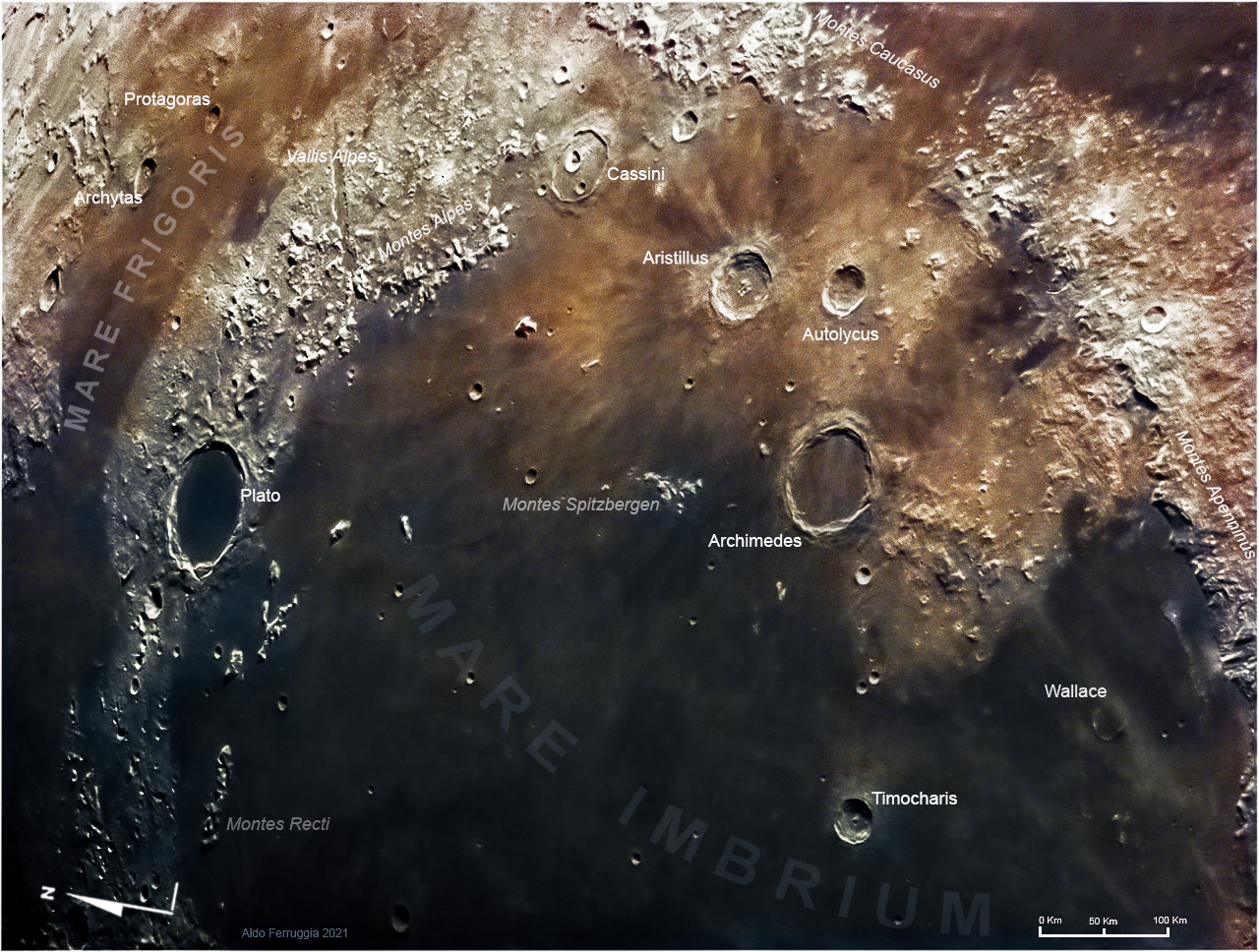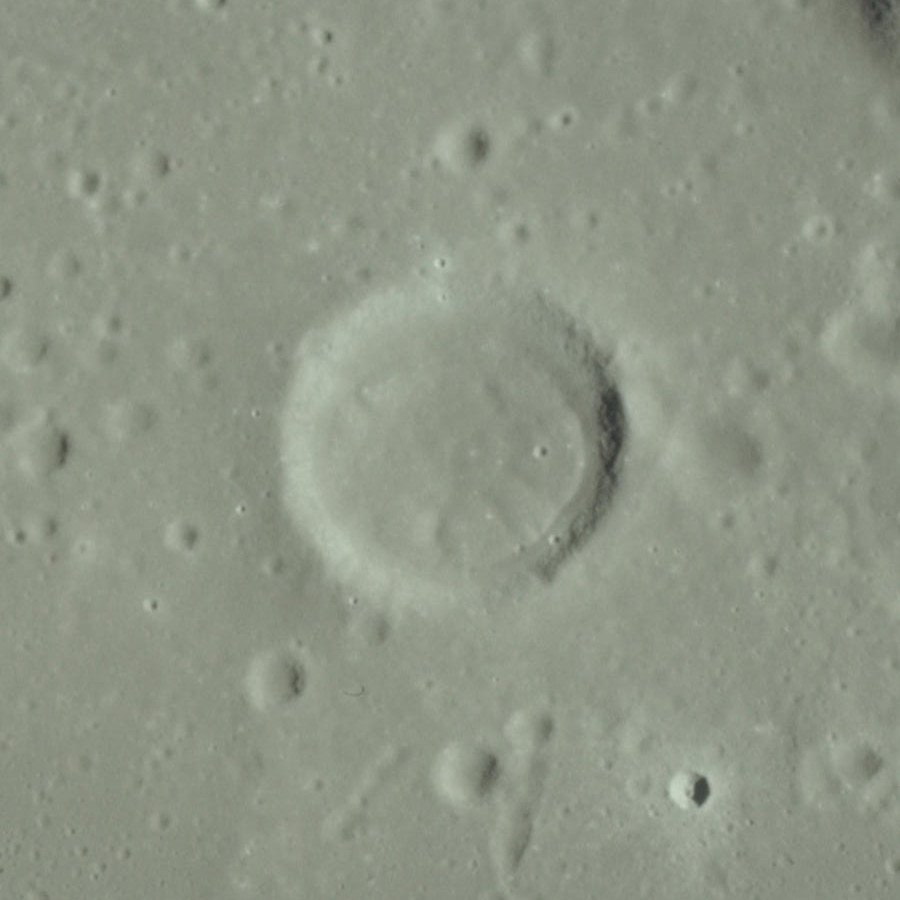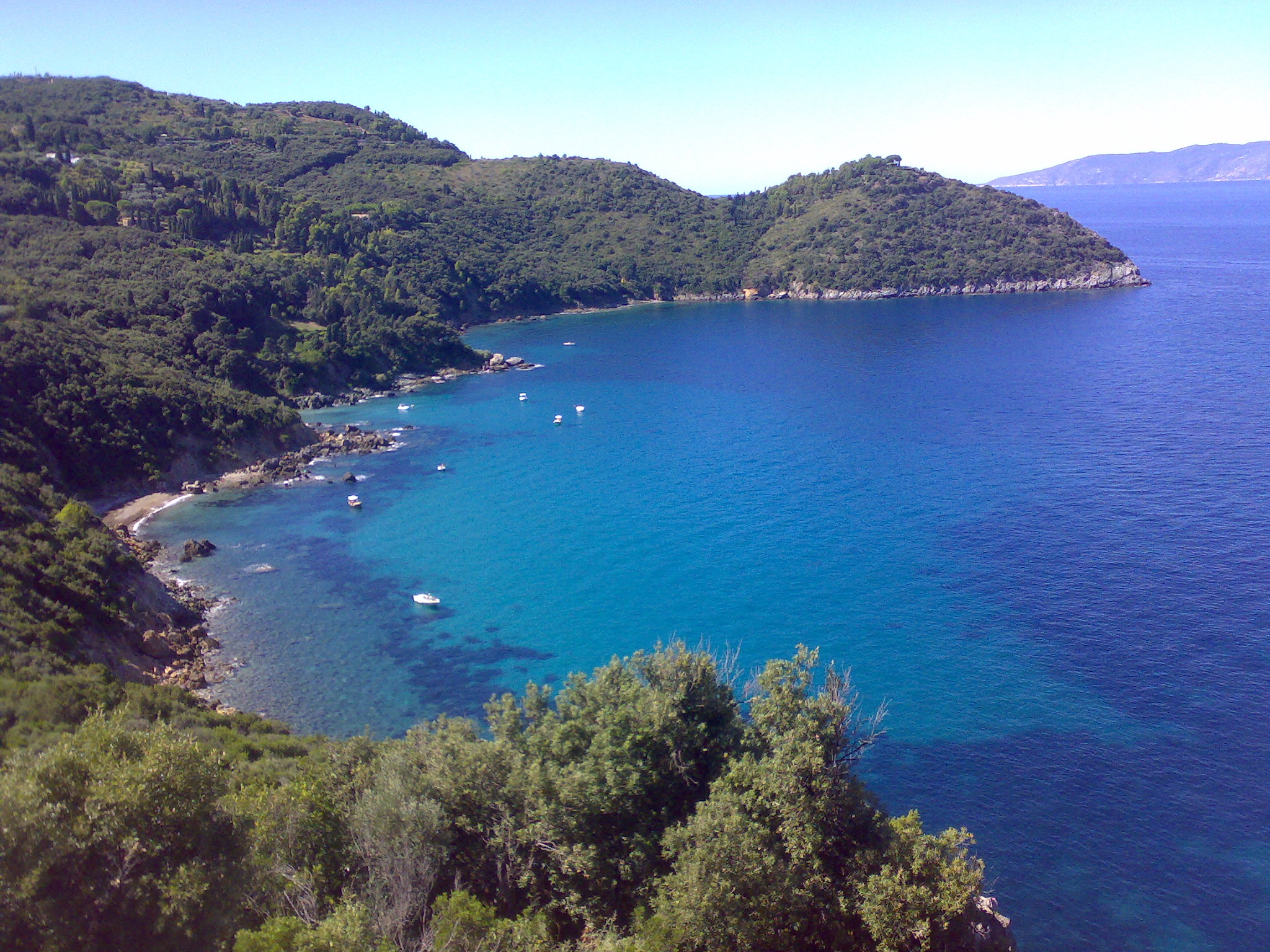|
Archimedes (crater)
Archimedes is a large lunar impact crater on the eastern edges of the Mare Imbrium. Its diameter is 81 km. Description The diameter of Archimedes is the largest of any crater on the Mare Imbrium. The rim has a significant outer rampart brightened with ejecta and the upper portion of a terraced inner wall, but lacks the ray system associated with younger craters. A triangular promontory extends 30 kilometers from the southeast of the rim. The interior of the crater lacks a central peak, and is flooded with lava. It is devoid of significant raised features, although there are a few tiny meteor craters near the rim. Scattered wisps of bright ray material lie across the floor, most likely deposited by the impact that created Autolycus. Surroundings To the south of Archimedes extends the Montes Archimedes, a mountainous region. On the southeastern rim is the Palus Putredinis, a lava-flooded plain containing a system of rilles named the Rimae Archimedes, which extends ove ... [...More Info...] [...Related Items...] OR: [Wikipedia] [Google] [Baidu] |
Lunar Reconnaissance Orbiter
The Lunar Reconnaissance Orbiter (LRO) is a NASA robotic spacecraft currently orbiting the Moon in an eccentric polar mapping orbit. Data collected by LRO have been described as essential for planning NASA's future human and robotic missions to the Moon. Its detailed mapping program is identifying safe landing sites, locating potential resources on the Moon, characterizing the radiation environment, and demonstrating new technologies. Launched on June 18, 2009, in conjunction with the Lunar Crater Observation and Sensing Satellite (LCROSS), as the vanguard of NASA's Lunar Precursor Robotic Program, LRO was the first United States mission to the Moon in over ten years. LRO and LCROSS were launched as part of the United States's Vision for Space Exploration program. The probe has made a 3-D map of the Moon's surface at 100-meter resolution and 98.2% coverage (excluding polar areas in deep shadow), including 0.5-meter resolution images of Apollo landing sites. The first images ... [...More Info...] [...Related Items...] OR: [Wikipedia] [Google] [Baidu] |
Giovanni Battista Riccioli
Giovanni Battista Riccioli, SJ (17 April 1598 – 25 June 1671) was an Italian astronomer and a Catholic priest in the Jesuit order. He is known, among other things, for his experiments with pendulums and with falling bodies, for his discussion of 126 arguments concerning the motion of the Earth, and for introducing the current scheme of lunar nomenclature. He is also widely known for discovering the first double star. He argued that the rotation of the Earth should reveal itself because on a rotating Earth, the ground moves at different speeds at different times. Biography Riccioli was born in Ferrara. He entered the Society of Jesus on 6 October 1614. After completing his novitiate, he began to study humanities in 1616, pursuing those studies first at Ferrara, and then at Piacenza. From 1620 to 1628 he studied philosophy and theology at the College of Parma. Parma Jesuits had developed a strong program of experimentation, such as with falling bodies. One of the most famous ... [...More Info...] [...Related Items...] OR: [Wikipedia] [Google] [Baidu] |
Lunar Orbiter 4
Lunar Orbiter 4 was a robotic U.S. spacecraft, part of the Lunar Orbiter Program, designed to orbit the Moon, after the three previous orbiters had completed the required needs for Apollo mapping and site selection. It was given a more general objective, to "perform a broad systematic photographic survey of lunar surface features in order to increase the scientific knowledge of their nature, origin, and processes, and to serve as a basis for selecting sites for more detailed scientific study by subsequent orbital and landing missions". It was also equipped to collect selenodetic, radiation intensity, and micrometeoroid impact data. Mission Summary The spacecraft was placed in a cislunar trajectory and injected into an elliptical near polar high lunar orbit In celestial mechanics, an orbit is the curved trajectory of an object such as the trajectory of a planet around a star, or of a natural satellite around a planet, or of an artificial satellite around an object or ... [...More Info...] [...Related Items...] OR: [Wikipedia] [Google] [Baidu] |
Spurr (crater)
Spurr is the lava-flooded remains of a lunar impact crater. It was named after American geologist Josiah Edward Spurr. It is located in the midst of the Palus Putredinis plain, to the southeast of the crater Archimedes. Only the southern half of the rim protrudes significantly through the lunar mare material, while the northern section of the wall has a resemblance to a ghost crater rim. The formation was known as Archimedes K before being renamed by the IAU. References * * * * * * * * * * * External links {{Commonscat LTO-41A3 Spurr— L&PI topographic map In modern mapping, a topographic map or topographic sheet is a type of map characterized by large- scale detail and quantitative representation of relief features, usually using contour lines (connecting points of equal elevation), but histori ... Impact craters on the Moon Mare Imbrium ... [...More Info...] [...Related Items...] OR: [Wikipedia] [Google] [Baidu] |
MacMillan (crater)
MacMillan is a bowl-shaped lunar impact crater on the eastern fringes of the Mare Imbrium. It was named after American mathematician and astronomer William Duncan MacMillan. It is located just to the southwest of a lone rise, near the southwestern edge of the Montes Archimedes. This is a cup-shaped depression in the surface with an interior albedo that matches the nearby lunar mare The lunar maria (; singular: mare ) are large, dark, basaltic plains on Earth's Moon, formed by ancient asteroid impacts on the far side on the Moon that triggered volcanic activity on the opposite (near) side. They were dubbed , Latin for 'seas' .... The edges of the rim have a somewhat higher albedo. It shows some indications of a concentric crater. This crater was previously identified as Archimedes F. References * * * * * * * * * * * External links Beer Lunar Topographic Orthophotomap LTO41A4, May 1974 {{Commonscat Impact craters on the Moon Mare Imbrium ... [...More Info...] [...Related Items...] OR: [Wikipedia] [Google] [Baidu] |
Bancroft (crater)
Bancroft is a small, bowl-shaped impact crater located to the southwest of Archimedes on the Mare Imbrium. A wide, shallow depression runs from the rim of Bancroft southeast to the Montes Archimedes. There are some clefts at the edge of the mare to the west and southwest of the crater. Other prominent craters are two small craters nearly to the west named Feuillée and Beer. Bancroft has a linear ridge in the center of its floor, which is unusual for a crater of 13 km diameter. It was named after American chemist Wilder D. Bancroft. Bancroft was previously identified as Archimedes A before being renamed by the IAU The International Astronomical Union (IAU; french: link=yes, Union astronomique internationale, UAI) is a nongovernmental organisation with the objective of advancing astronomy in all aspects, including promoting astronomical research, outreach ... in 1976. References * * * * * * * * * * * External links * Impact craters on the Moon Mar ... [...More Info...] [...Related Items...] OR: [Wikipedia] [Google] [Baidu] |
International Astronomical Union
The International Astronomical Union (IAU; french: link=yes, Union astronomique internationale, UAI) is a nongovernmental organisation with the objective of advancing astronomy in all aspects, including promoting astronomical research, outreach, education, and development through global cooperation. It was founded in 1919 and is based in Paris, France. The IAU is composed of individual members, who include both professional astronomers and junior scientists, and national members, such as professional associations, national societies, or academic institutions. Individual members are organised into divisions, committees, and working groups centered on particular subdisciplines, subjects, or initiatives. As of 2018, the Union had over 13,700 individual members, spanning 90 countries, and 82 national members. Among the key activities of the IAU is serving as a forum for scientific conferences. It sponsors nine annual symposia and holds a triannual General Assembly that sets policy ... [...More Info...] [...Related Items...] OR: [Wikipedia] [Google] [Baidu] |
United States Geological Survey
The United States Geological Survey (USGS), formerly simply known as the Geological Survey, is a scientific agency of the United States government. The scientists of the USGS study the landscape of the United States, its natural resources, and the natural hazards that threaten it. The organization's work spans the disciplines of biology, geography, geology, and hydrology. The USGS is a fact-finding research organization with no regulatory responsibility. The agency was founded on March 3, 1879. The USGS is a bureau of the United States Department of the Interior; it is that department's sole scientific agency. The USGS employs approximately 8,670 people and is headquartered in Reston, Virginia. The USGS also has major offices near Lakewood, Colorado, at the Denver Federal Center, and Menlo Park, California. The current motto of the USGS, in use since August 1997, is "science for a changing world". The agency's previous slogan, adopted on the occasion of its hundredt ... [...More Info...] [...Related Items...] OR: [Wikipedia] [Google] [Baidu] |
Luna 2
''Luna 2'' ( rus, Луна 2}), originally named the Second Soviet Cosmic Rocket and nicknamed Lunik 2 in contemporaneous media, was the sixth of the Soviet Union's Luna programme spacecraft launched to the Moon, E-1 No.7. It was the first spacecraft to reach the surface of the Moon, and the first human-made object to make contact with another celestial body. The spacecraft was launched on 12 September 1959 by the Luna 8K72 s/n I1-7B rocket. It followed a direct path to the Moon. In addition to the radio transmitters sending telemetry information back to Earth, the spacecraft released a sodium gas cloud so the spacecraft's movement could be visually observed. On 13 September 1959, it impacted the Moon's surface east of Mare Imbrium near the craters Aristides, Archimedes, and Autolycus. Prior to impact, two sphere-shaped pennants with USSR and the launch date engraved in Cyrillic were detonated, sending pentagonal shields in all directions. ''Luna 2'' did not detect radiati ... [...More Info...] [...Related Items...] OR: [Wikipedia] [Google] [Baidu] |
Soviet Union
The Soviet Union,. officially the Union of Soviet Socialist Republics. (USSR),. was a List of former transcontinental countries#Since 1700, transcontinental country that spanned much of Eurasia from 1922 to 1991. A flagship communist state, it was nominally a Federation, federal union of Republics of the Soviet Union, fifteen national republics; in practice, both Government of the Soviet Union, its government and Economy of the Soviet Union, its economy were highly Soviet-type economic planning, centralized until its final years. It was a one-party state governed by the Communist Party of the Soviet Union, with the city of Moscow serving as its capital as well as that of its largest and most populous republic: the Russian Soviet Federative Socialist Republic, Russian SFSR. Other major cities included Saint Petersburg, Leningrad (Russian SFSR), Kyiv, Kiev (Ukrainian Soviet Socialist Republic, Ukrainian SSR), Minsk (Byelorussian Soviet Socialist Republic, Byelorussian SSR), Tas ... [...More Info...] [...Related Items...] OR: [Wikipedia] [Google] [Baidu] |
Italy
Italy ( it, Italia ), officially the Italian Republic, ) or the Republic of Italy, is a country in Southern Europe. It is located in the middle of the Mediterranean Sea, and its territory largely coincides with the homonymous geographical region. Italy is also considered part of Western Europe, and shares land borders with France, Switzerland, Austria, Slovenia and the enclaved microstates of Vatican City and San Marino. It has a territorial exclave in Switzerland, Campione. Italy covers an area of , with a population of over 60 million. It is the third-most populous member state of the European Union, the sixth-most populous country in Europe, and the tenth-largest country in the continent by land area. Italy's capital and largest city is Rome. Italy was the native place of many civilizations such as the Italic peoples and the Etruscans, while due to its central geographic location in Southern Europe and the Mediterranean, the country has also historicall ... [...More Info...] [...Related Items...] OR: [Wikipedia] [Google] [Baidu] |
Monte Argentario
Monte Argentario is a ''comune'' (municipality) and a peninsula belonging to the Province of Grosseto in the Italian region Tuscany, located about south of Florence and about south of Grosseto. The peninsula is connected with the mainland by three spits of land which form two lagoons, the ''Laguna di Ponente'' on the west side and the ''Laguna di Levante'' on the east side of the middle dam. The two main villages on Monte Argentario are Porto Santo Stefano, chief town, facing north, and Porto Ercole facing south. The panoramic road ''Strada panoramica'' starts in Porto Santo Stefano allowing splendid views of the coast and the Tuscan Archipelago. Monte Argentario borders the ''comune'' of Orbetello, which is located on the middle dam between the two lagoons. Geography Monte Argentario is a promontory stretching towards the Tyrrhenian Sea in correspondence of the two southernmost islands of the Tuscan Archipelago, Giglio and Giannutri. The promontory was an island in the pa ... [...More Info...] [...Related Items...] OR: [Wikipedia] [Google] [Baidu] |

_launches_with_LRO_and_LCROSS.jpg)






